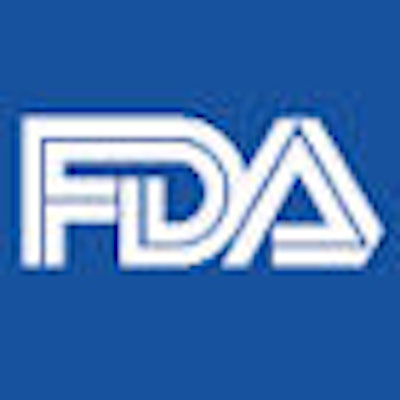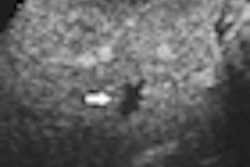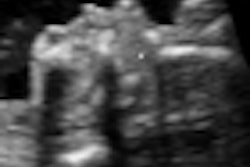
Is the U.S. Food and Drug Administration (FDA) preparing to remove its black box warning for ultrasound contrast agents? That's what proponents of the technology are hoping after an advisory committee meeting earlier this month on ultrasound contrast safety.
Vendors and physicians believe they made a strong case for the safety profile of ultrasound contrast agents during a May 2 joint meeting of the FDA's Cardiovascular and Renal Drugs Advisory Committee and the Drug Safety and Risk Management Advisory Committee. The meeting was called to review new safety data published since October 2007, when the FDA required ultrasound contrast products to carry black box warnings.
Although this month's meeting did not include a formal vote on whether or not to recommend removal of the black box warning, many observers believed that an informal show of hands at the end of the session showed either a narrow majority favoring removal or a toss-up.
Either way, the FDA summary minutes of the meeting highlighted the divergence of opinion among the committee members.
Most committee members did not agree on the options for modifying the boxed warnings for these products. Some members questioned why the boxed warnings were included for the products originally and felt that the boxed warnings should be removed or the language requiring specific monitoring softened. Some also were concerned that leaving the boxed warnings as is may lead to less use of the products in cases where they may be beneficial. Others did not feel that the data presented justified removal or softening of the boxed warning. A comment was made that removing the boxed warning would signal a stronger endorsement of the new data than the committee felt comfortable with. Several members also noted that boxed warnings do not always preclude the use of drugs, and that sales data of ultrasound contrast agents in the United States have rebounded even after the prior addition of the boxed warnings.
The joint advisory committee meeting was held to review the design and results of required postmarketing studies from GE Healthcare and Lantheus Medical Imaging, recent postmarketing data for their Optison and Definity agents, and recent clinical trial and postmarketing data from Bracco's investigational SonoVue agent. Because the FDA's Center for Drug Evaluation and Research (CDER) did not seek advice on approval of specific agents, no voting was required, according to the FDA.
In its presentation, GE highlighted the three postmarketing safety studies performed on its Optison agent; the studies showed no statistically significant risks and no safety signals from the use of Optison, said Dr. Brian Robinson, medical director for Optison.
"Based on these studies, which included nearly 4,000 patients receiving Optison, and the amount of Optison safety data, we do not believe a boxed warning is clinically warranted," Robinson told AuntMinnie.com. "We believe our prescribing information adequately reinforces the need to evaluate all patients for any condition that would preclude use of Optison."
Lantheus also presented two postmarketing studies on its Definity agent: a retrospective study evaluating nearly 32,000 patients, and three years of surveillance data. The company judged the meeting to be a success and a confirmation of the strong benefit-risk profile of ultrasound contrast agents, said Dr. Mark Hibberd, PhD, senior medical director of global medical affairs and pharmacovigilance.
"The goal of our presentation was to reinforce that Definity is well-tolerated among high-risk patients and has a stable, well-characterized safety profile," Hibberd said. "During the three years since the last FDA advisory committee meeting, there have been no significant changes to the Definity safety profile."
Bracco, which is seeking FDA clearance for its SonoVue contrast agent, also presented recent clinical trial and postmarketing data. Clinical pharmacology studies showed no significant effect of SonoVue on pulmonary hemodynamics, pulmonary function, blood pressure, oxygen saturation, vital signs, cardiac function, and electrocardiography parameters, according to Dr. Alberto Spinazzi, senior vice president of group medical and regulatory affairs.
"We also showed safety data from clinical trials, postmarketing surveillance, and peer-reviewed literature that suggest that the rate and type of adverse events following the administration of SonoVue is similar to that reported for Definity and Optison," Spinazzi said.
Study design issues
A number of committee members raised concerns over the Definity and Optison observational study designs, focusing on factors such as their retrospective nature and reliance on administrative databases.
Members noted that observational studies are important for assessing safety signals in the postmarketing phase; however, they also noted that the databases from observational studies have important limitations (e.g., lack of precise time of death, potentially unequal matching due to hidden covariates, cause of death) and that the results do not appear to be robust and are difficult to interpret. Members commented on the studies presented and noted that the Sponsors (GE Healthcare and Lantheus Medical Imaging, Inc.) used the same database; however, differences in the time periods studied and in the analytical approaches resulted in discordant results. Members commented on the use of propensity score matching and the lack of confidence in this matching technique to appropriately balance the different groups. Some members felt that these studies could be more informative if redone by an independent third party with analysis of the raw data from the Premier database and with simultaneous comparison of the two agents with the same methodology.
Overall, the committee felt that the observational study data should not be included in the labeling based on the designs of the studies and the limitations of the results, according to the summary minutes. But several members believed the results of the safety registry and pulmonary hemodynamic studies were robust enough to include in labeling.
The committee did feel that the pulmonary hemodynamic studies provided "reasonable assurance" that the agents do not cause significant pulmonary hemodynamic changes, but members did not feel these results were conclusive, according to the summary minutes.
Black box impact
However, criticism of these study designs, while valid, has nothing to do with the demonstrated safety record of these agents, said Dr. Paul Grayburn, a professor of medicine and a cardiologist at Baylor University Medical Center in Dallas. Grayburn presented at the meeting on behalf of the International Contrast Ultrasound Society (ICUS).
"The agents have been shown to be safe and have shown to be safer than other tests that would be done in their stead," he said. "So the black box warning should be removed, regardless of the limitations of those studies. And a number of members of the committee stated that."
Grayburn presented the ICUS view that there is no justification for the black box warning, which has drastically curtailed the use of echocardiography contrast agents in the U.S. The organization believes the black box warning adversely affects patients.
"Patients who should be getting [ultrasound contrast agents] aren't getting them," he said. "What that means is, if you get an echocardiogram and you don't make the diagnosis, you're guessing as to what treatment is. It's very important to make the diagnosis before one can know what treatment is needed. So removal of these agents has really hurt the ability to make a diagnosis, particularly in acutely ill patients."
Data presented by ICUS and in other presentations showed a dramatic reduction in the usage of agents since the black box warning was issued. While utilization has slowly begun to come back up, it has not yet reached the level of usage prior to the black box warning, either in absolute terms or in terms of percentage of patients who probably should get these agents, Grayburn said.
Grayburn noted that the Intersocietal Commission for the Accreditation of Echocardiography Laboratories (ICAEL), as well as the American Society of Echocardiography (ASE), the American College of Cardiology (ACC), and the American Heart Association (AHA), recommend that ultrasound contrast agents be used under certain circumstances.
"If agents have a black box warning on them and they are considered necessary by accrediting agencies, that seems to be a conflict," Grayburn said.
The reduction in contrast use was also highlighted during a presentation by ASE president-elect Dr. Jim Thomas. While ASE appreciated that the FDA relaxed its black box warning in May 2008, it emphasized the lingering effects of the warning.
"Several institutions have decided to stop using contrast altogether, a situation that has persisted despite the new label, resulting in nondiagnostic echocardiograms and the need for additional, alternative testing, posing added safety risks to the patient and increasing costs to the healthcare system," Thomas said in his statement.
Thomas also stressed the clinical utility and safety record of ultrasound contrast agents, and he urged the FDA to also look to the future in assessing agents.
"Practicing physicians use ultrasound contrast agents for a number of indications beyond those currently approved by the FDA," he said in his statement. "These include, among others, stress echocardiography (for left ventricular opacification), vascular imaging, and myocardial perfusion imaging. The administration of contrast for these and other indications is supported by numerous studies. ASE believes that echocardiography contrast agents have broad applications beyond those currently approved."
The need to expand clinical indications for ultrasound contrast to include radiology applications was also emphasized by Dr. Barry Goldberg of Thomas Jefferson University in his talk representing the American College of Radiology (ACR) and the American Institute for Ultrasound in Medicine (AIUM).
Black box fate?
Contrast advocates expressed hope that the meeting might prompt the FDA to remove the black box warning.
Based on the totality of data available, the majority of the panel appeared to recognize the safety of ultrasound contrast agents. GE's Robinson said.
"Importantly, the removal of the boxed warning [would] increase care for a number of critically ill patients who may not otherwise receive the optimal benefits of echocardiograms because of unfounded safety concerns associated with a boxed warning," Robinson said. "Further, alternative procedures may place these patients at an equivalent and, in many cases, higher risk for adverse events."
The advisory committees acknowledge that the demonstrated clinical utility of contrast echocardiography outweigh the small risks of adverse reactions, which are lower than the risks of many other commonly used diagnostic procedures, Lantheus' Hibberd said.
With the advisory committees’ review completed, it’s now up to the FDA to mull over the results of the meeting and decide what steps it will take in its ongoing and controversial regulation of ultrasound contrast agents. The FDA has not announced when a decision can be expected.




















